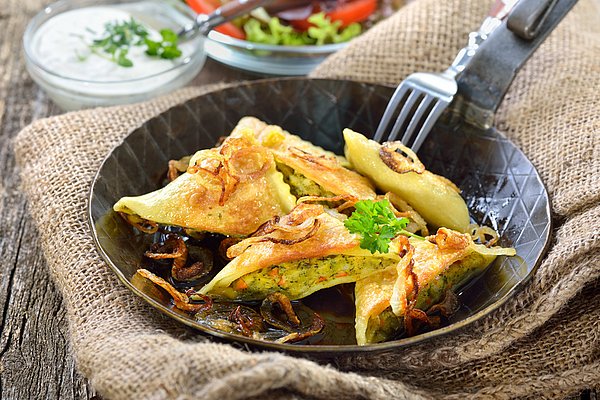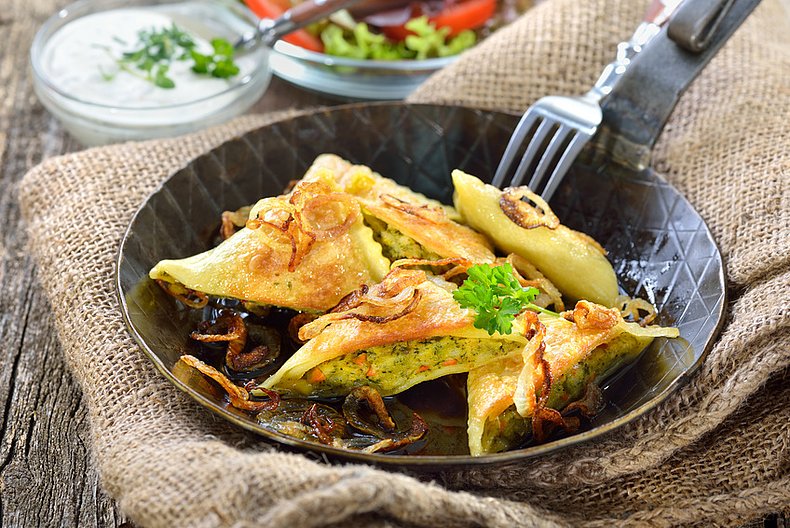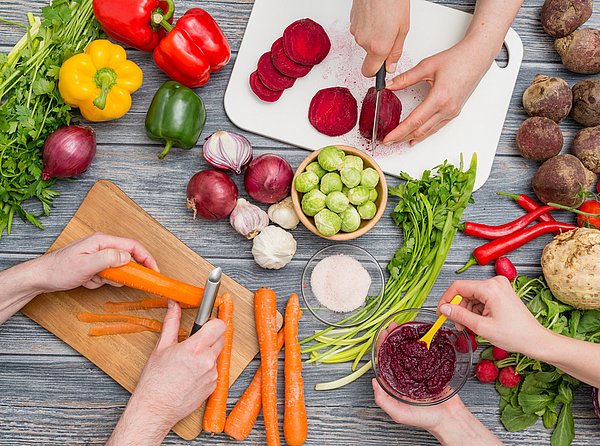German food and eating habits
Besides the culture, mentality, and people of a country, traditional food is always something worth to explore while living abroad. Nowadays food is something really precious for most persons and has a big impact on the quality of life. Moreover, it is part of the culture of a country – at least for those who do not suffer from a lack of food. As a student in a different country it can be quite interesting to try new dishes, local delicacies and experience typical eating habits and traditions in contrast to those you are already used to from your country of origin. If you plan to go to Germany as a student, there is so much more to explore than is knows by its stereotypes. Besides the internationally famous dishes “Sauerkraut”, “Knödel”, “Currywurst” and “Schnitzel” you can also find plenty of meals which are rather unknown outside of Germany but follow a long tradition and a specific recipe.
Eating habits
First of all, there is something that might confuse foreigners about German eating habits. The typical meals are divided in a rather copious breakfast (6 am – 8 am), lunch (12 pm – 2 pm) and dinner (6 pm – 8 pm). Breakfast usually consists of bread that can be topped with cheese, cold cuts, jam, honey, Nutella etc., if you prefer something salty.People who are more into sweet and fruity food often prefer cereals or porridge with yoghurt and fruits. For lunch, it is typical to have a warm dish while at the evening most Germans just have a light meal typically made of bread or salad. Lunch and dinner can possibly be switched because of ones personal daily routine. Still, it is very common to only have one “warm” dish per day which is quite different in lots of other countries and therefore may seem awkward for some.
Cooking German dishes without any previous experience or instruction of someone who really knows German kitchen can be very challenging. Most dishes are time-consuming to prepare and need specific ingredients as well as a good recipe and an adequate instruction. If you really want to try it, you can just visit one of the restaurants offering typical German food first. No matter if you are in the south of Germany, in the western part or near the coast in the north - you can be sure to get a meal well prepared by someone who really knows how to cook according to the traditional recipe. Bellow you can find some examples of traditional dishes and specialties from different regions of Germany, mostly finding their roots and influences in the EastEuropean kitchen and former Prussia.
"Königsberger Klopse" (meatballs)
Starting with a dish that originally has been created in former East Prussia but is a common part of traditional the German cuisine. Its meatballs are served with a famous, sourly sauce made of cream and capers and usually potatoes (the favorite side-dish of Germans). Some also add vegetables like fresh beetroot.
Kale/green cabbage with "Pinkel" (special sausage)
This dish consists of two very typical German ingredients: Firstly, the kale which is very common to eat during winter and secondly, the special pork sausage called “Pinkel”. This hearty meal which is especially known and popular in the northwest is usually served with a portion of boiled potatoes.
Meat roulades with red cabbage and "Knödel" (dumplings)
Roulades are originally stuffed with mustard, onions, bacon and pickles. They are often served with red cabbage, “Knödeln” (German dumplings) and a brown sauce. Preparing this dish needs time and cooking-skills and is therefore rather known as a meal for special occisions like Christmas.
"Sauerbraten" (marinated pot roast)
It takes plenty of time to prepare a classic “Sauerbraten” that actually tastes like it should. The meat needs to be pickled for two up to seven days before the actual cooking. Pickling in this context means putting the meat in a marinade of vinegar, herbs, soup vegetables and red wine. This gives the meat a very special taste, that mixture of sour and spicy aroma the dish is famous for. The marinade afterwards will be further processed into a delicious sauce and topped and served with raisins, self-made “Spätzle” (description below) and red cabbage.
"Maultaschen" (filled pasta)

These filled noodles are a specialty of the Swabians in the south of Germany. They are originally filled with minced meat, veal meat, spinach and parsley. Cut into pieces and roasted in butter, inside of a broth or added with roasted onion rings and potato salad, they can be served in many different ways and therefore never become boring.
Fun fact: “Maultaschen” are also called “Herrgottsbescheißerle” (means: little God-cheaters) in its origin because of a legend saying they only exist because monks tried to hide meat from god in the fasting period in those pasta bags.
Potato salad
Potato salad is definitely one of the most famous German dishes and has one imporatnt advantage: You don’t need to be a chef with high cooking-skills to prepare it, you just need a little bit of time. The two most common kinds of potato salad are the one with vinegar-oil-vinaigrette and onions which is especially popular in southern Germany and its creamy alternative with a mayonnaise-yoghurt-dressing and (most of the time) pickles, onions, eggs and sausage which is more commen in the north. They both can be served warm but especially in summer during the barbecue-season they are even more delicious when eaten cold.
"Schupfnudeln" (noodles made out of potatoes)
“Schupfnudeln” are not only popular in teir origin, the southern region of Germany, but also loved in Austria. These special noodles are made out of potatoes, tasting like their Italian pendant gnocchi and looking like very thick noodles. They can be served in a spicy way with “Sauerkraut” (pickled cabbage) and bacon or as well in a sweet way when made with poppy seeds, cinnamon, sugar and stewed apples.
"Spätzle" (noodles)
German “Spätzle” are like the pasta in Italy: The most typical noodles of the country. They are a very likely side-dish of meaty dishes like “Sauerbraten” (explained before) or especially in the south served as cheesy “Spätzle”. Besides the noodles, this classic recipe consists of the layering of lots of Swiss “Emmentaler” cheese, bacon and onions.
"Christstollen" (Christmas stollen)
This special cake follows a long-lasting tradition over centuries and is a typical German dessert during the winter-season. It contains ground almonds, raisins, spices, candied lemon peel and candied orange peel. The sweet bread is most famous in Dresden and the surrounding region and most likely eaten before and during Christmas.
"Berliner/Krapfen/Pfannkuchen"
The sweet dessert “Berliner”, as well called “Berliner Ballen”, “Krapfen” or in Berlin itself “Pfannkuchen” (pancake), is a typical German cake that is often served during carnival or at New Year’s Eve. The fried dough is mostly topped with sugar or a sweet glaze and filled with jam, mouse or a kind of pudding cream. They are quite similar to an American donut – but they contain a sweet filling and their form is different.
Obviously the German kitchen offers much more than the dishes mentioned above – from the infamous “Zwiebelkuchen” (kind of a salty cake made out of onions) and potato-soup to “Pannfisch” (a northern traditional meal with special fish) and so on. Nevertheless, the listes dishes are really worth the try for someone who wants to get to know traditional German food. In general, German meals are mostly very hearty and contain a lot of meat – served in different shapes and ways. Most of the meals unfortunately need a lot of time and are difficult to prepare without any cooking-experience. However, as a student it would be good to know some facts about how to cook most easily, time-saving and affordable. Below you can find some tips about what to be aware of and what can be said in general about the eating behavior of students in Germany.
Some tips
On a long day spent studying at the university, you might not always have enough time to cook or be in a mood to do so afterwards. In this case you can always rely on the cafeteria of your university, the so called “Mensa”. Offering different dishes every day (including vegetarian and vegan meals) for little money, it can be considered as a really good alternative to self-made meals. What helps a lot is the “Mensa”-card you receive as a student and on which you can upload money to use in the canteen. As a student you always pay less than employees and people from outside, which makes eating in the canteen very affordable. What is even better is to cook for yourself – so you can save a lot more money. Go buy groceries in one of the many discount-supermarkets we have in Germany. According to the prices of food their offers are quite similar – from Lidl and Aldi up to Real, Combi and Netto, you can get the ingredients for your meal very easily.
There exists this stubborn cliché that German students just eat fast food, instant meals like Ravioli out of a can and noodles with tomato sauce. Fact is: Times have changed. Of course, German students eat Döner, pizza and Co. from time to time but they also got more interested into cooking for themselves, healthy and conscious eating. Even if it is hard to manage student life, self-cooked meals and more important money-saving cooking, it doesn’t mean that it is impossible. Every student should have at least basics like potatoes, rice, noodles or even couscous and bulgur at home. Because of the big packages and their long durability, you can use these products often and arrange and serve them in various and delicious ways. If you add some vegetables (quite affordable: zucchini, broccoli, “Kohlrabi”, carrots, tomatoes, pepper, onions, beans etc.) and some herbs and spices, you can easily create very tasty meals. Those of you, who wants to add some meat or fish can for instance just add some minced meat, chicken, salmon filet, trout filet or shrimps. To save some time you can just cook bigger portions (keyword: meal prep) to avoid cooking the days after your cooking-session or to have a mealto take to university the next day.
A tip for all those whose fruits and vegetables tend to rot in such a short time: Do not fully resist to buy fresh vegetables and fruits (contain lots of vitamins and important nutrients) but reduce the amount and add some frozen food you can use several times and whenever you want to.
If you still have difficulties to eat in a healthy, time- and money-saving way and you are not able to go to the canteen either, there is still the possibility to order some food from a delivery service. Especially a student’s hangover can sometimes become so much better with this alternative. But be aware of the fact that this should not become your daily routine. It would neither be healthy for you nor would you be able to save money.
What exactly you prefer to eat and where and how it is prepared finally lies in your hands – or should I say: In your mouth? The tips only should give you helpful advice and should show you how the student situation in Germany is according to healthy and conscious eating. Always keep in mind: Who studies a lot also has to eat sufficiently!





